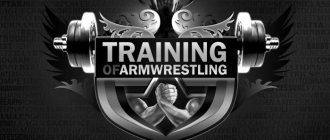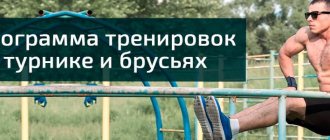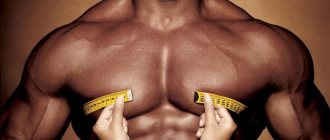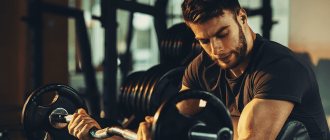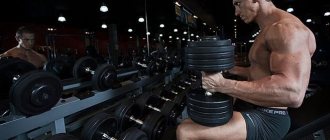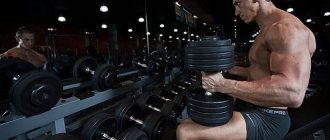Author of the article
Andrey Belozertsev
Drawing up programs for effective muscle mass gain.
Strong hands are not only beautiful, but also useful.
There are a huge variety of training sets aimed at working out the small muscles of the forearms, wrists and hands.
However, if you want to become an arm wrestling champion, you cannot do without specialized exercises.
In this article you will learn how to pump up your arms for arm wrestling before you start moving professionally in this area of wrestling.
Features of arm wrestling training
Training to prepare for competitions in this sport is very specific. The exercises have a lot of features.
The main goal is to develop strength, and not to acquire beautiful relief or impressive muscle mass.
Main muscles involved:
- deltas of the shoulder (all beams: posterior, anterior and middle);
- latissimus dorsi muscles;
- all muscle groups of the forearm;
- biceps;
- triceps;
- press.
The ligaments and tendons of the hand are also well worked out. In some cases, even the leg muscles are trained during preparation for tournaments!
Therefore, despite the name, it cannot be said that arm wrestling is aimed only at the hands.
Contraindications to training
All training in arm wrestling has an impact on strengthening the muscles and joints in the arms and hands. If an athlete experiences pain in the involved parts of the body during exercise, they should stop performing the exercises to prevent injury. You should also not engage in this sport if you have injuries to the shoulder, elbow and wrist joints and if you have chronic and inflammatory diseases of the hand joints.
Those arm wrestlers who have high blood pressure and heart disease should approach training with great care. If you have such problems, you should consult a doctor. If an athlete falls ill with ARVI or is poisoned, admission to classes should be prohibited. First you need to fully recover, and only after that return to classes.
Exercises for the wrist and forearm
Hammer or single-sided dumbbell lift
In this case, the projectile should be a piece of iron in the form of a lever - with a weighting agent only at one end.
Dumbbells with removable weights or an improvised apparatus - a hammer or sledgehammer - may be suitable.
In some cases, such equipment is used by athletes who study martial arts, because the dumbbell handle imitates the grip of an opponent.
Exercise technique:
- Starting position: standing, back straight, feet shoulder-width apart, arms extended along the body.
- The projectile can be taken with any type of grip in one palm. Moving the hand in a plane parallel to the side, you need to raise and lower the dumbbell by bending your arms at the wrist joint.
- Perform this exercise in both directions: the weight at the end of the apparatus should be directed forward and backward.
- Minimum number of repetitions: 2-3 sets of 20-25 movements.
Previously, we talked about how to remove your butt.
Extension of the hand with weights
This exercise pumps up your fingers, forearms and hands very well. You can use a dumbbell or an empty barbell.
The exercise consists of the following steps:
- Starting position: sitting on a bench, back straight, body slightly tilted forward. The forearms should be placed completely on the hips so that the hands, palms up, hang from the knees with the implements.
- Slowly lift the dumbbell by bending your wrist, hold at the top point for 4-5 seconds and return to the starting position.
- The mass of the apparatus must be large so that even 10-12 repetitions in a row cause noticeable fatigue.
Do the minimum: 2-3 sets of 20 reps.
It will be interesting to know how to remove the belly and sides.
Horizontal lift arm
This element of training is very specific. You need to do it this way:
- Starting position: lying on a gymnastic mat, arms pressed to the body, legs straightened.
- Hold a lever (hammer, single-sided dumbbell, or baseball bat) in one hand with a neutral grip. Raise the hand so that the equipment takes a position perpendicular to the floor.
There are a lot of repetitions that need to be done, so it’s easier to give the exercise time - at least five minutes.
Correct stance
Step 1.
We grab the pin with our non-working hand.
Important:
Do not completely release the pin.
Step 2.
The athletes' hands are positioned in such a way that the grip is in the middle, the phalanges of the fingers should be open.
Important:
you must not cover your opponent’s fingers.
Step 3.
Athletes' shoulders should be parallel to the table.
Step 4.
The elbow of the struggling hand rests on the pillow on the table.
Important:
you can slide your elbow along the pillow, but you cannot lift your elbow from it.
Step 5.
Take a position that is comfortable for you.
You can even rest your feet on the legs of the table on which you are wrestling. Important:
if your legs interfere with your opponent, the referee will stop the game.
Photo: Mark Kolbe/Getty Images
Additional exercises for the forearms
Forearm flexion
Arm wrestling exercises are not only aimed at the hands and wrists.
The so-called forearm hammer curl works great for the biceps.
The execution technique consists of the following steps:
- While standing or sitting on a bench, you need to place your upper limbs along your body, holding heavy dumbbells with a neutral grip.
- As you exhale, you need to lift the projectile to your chest, turning your hand inward. Thus, the dumbbell is in a vertical position - its plates are located one above the other.
- After holding for 2-3 seconds in this position, smoothly lower your hand.
These wrist and elbow curls are considered basic, so you need to perform three sets of 15-20 repetitions.
In another article, we discussed how to get toned abs in a week.
Pull-ups with a towel
In this case, regular pull-ups on a horizontal bar will do, but you don’t need to hold onto the bar with your hands, but hang on strong towels thrown over the pipe.
The towels should be identical, it is also recommended to align the free ends of the fabric.
Towels should be placed on the horizontal bar at shoulder width. You should pull up slowly to effectively work your biceps and triceps, hand and finger muscles, shoulder deltoids, chest and upper back.
Such activities are also a good workout for the wrist ligaments.
Power wrist curls
The amplitude during execution must be very large for the bending effect to appear.
It is recommended to use a barbell, but beginners can substitute dumbbells with interchangeable weights.
You need to sit on a bench, place your forearms on your thighs, and hold a barbell or heavy dumbbells in your palms.
Flexion must be performed exclusively with the wrist joint until the metacarpus is completely contracted. Perform 10-15 lifts of the projectile.
The load in some cases can be very heavy, so it is recommended to train under the guidance of a certified instructor.
However, in order to pump up massive arms, arm wrestling is not enough.
Therefore, you need to pay attention to comprehensive training of the whole body, including not forgetting about cardio elements that are beneficial for the heart and lungs.
Exercises that professional arm wrestlers use for their own training
Professional arm wrestlers use a large number of exercises for training, which help develop the desired muscle group, strength and power. Among them are the following exercises:
- Standing biceps curl . Refers to the most productive preparations for the development of biceps, back and forearm. A bar with a thick handle is used, or an elastic band is additionally put on to increase the volume. The barbell should not be lifted to its full amplitude.
- Lifting the barbell onto the wrist . To do this, the wrestler needs to take the apparatus in his hands and place his forearms on the bench. Palms should be facing up. Then you need to lift the barbell by bending your wrist towards your body. The exercise can be performed with one hand to increase the load.
- Lifting a kettlebell with a hand with two hands . Forearms should be placed on the bench. Grab the kettlebell with both hands so that your palms face each other and your thumb points up. You need to lift the weight by flexing and extending your wrist.
- Pull on the upper block into a hook or upward . The exercise is performed either on an arm wrestling table or in a standing position. The simulator must have a large diameter handle. To perform the exercise, the athlete needs to grab the apparatus and pull it towards the chest, while pressing the elbow to the body.
- Lifting a dumbbell onto the brachioradialis muscle on a Scott bench . The fighter needs to take the dumbbell with a hammer grip and begin to lift the projectile in an incomplete amplitude. The arms extend no more than 100-120 degrees in the lower position.
- Wrist and biceps workouts . A rubber band or expander is used. The exercise uses different angles and simulates sparring.
- Pronation and supination training . In the first case, you should twist the hand with your thumb in your direction. To develop supination, a block using a strap is used.
- Holding and lifting large weights with your fingers;
- Dumbbell bicep hold . Performed at a right angle at the elbow joint.
- Pull-ups . This exercise allows you to strengthen your biceps and back muscles. It should be performed in an incomplete amplitude with an explosive movement: at the top point, the palms should come off the bar slightly, and at the bottom, the elbows should remain slightly bent.
- Hanging on the bar . To perform this, the athlete must bend his elbows at a right angle.
To train the shoulder girdle, barbell and dumbbell presses are used in a standing position, dumbbell swings across the sides and to the rear delta. Bench press and dips are used to strengthen the triceps, chest and deltoid muscles. These exercises are basic and affect the production of testosterone, which is used to increase muscle mass.
In addition to training, all wrestlers should engage in sparring with a partner. Professional athletes need to do this once a week, and beginners – once every two weeks.
In conclusion, we note that the public is often mistaken in the fact that arm wrestling is a simple sport. This is wrong. In this martial arts, much attention is paid to the correct technique to avoid injury, the strength of the arms and hands, and the speed of reactions. To develop explosive power, a large number of training sessions are used, which can be carried out both in the gym and at home. These exercises are aimed at strengthening the necessary muscles and joints, and with proper training, the athlete’s chances of winning increase.
Exercise No. 1 – Horizontal or block row
Row in a horizontal block
Row in a horizontal block is Denis Tsyplenkov’s favorite exercise for arm wrestling. He admits that he includes it in almost every workout. However, there are certain implementation specifics here.
- Stand up to the simulator;
- Grasp the handle;
- Resting your elbow - your hand, table or side, it doesn’t matter;
- Start by twisting the brush;
- Then change hands and repeat the exercise.
Now let's look at the nuances of performing this arm wrestling exercise. The first thing to consider is the elbow support; for this you can use a table or put your free hand under it. You need to do it at least 20 times in three approaches, and this is just the beginning, then the number of repetitions, working weight and approaches should be increased in order to develop powerful forearm muscles.
Home workout program
With the help of exercises from a properly created arm wrestling training program for beginner girls, you can work not only the strength of the arm muscles, but also other important muscles. For a more worthy result, it is necessary to constantly improve physical development indicators and strictly follow the rules of a healthy lifestyle.
Strength exercises must be performed with the highest weight and the smallest number of repetitions (up to 6 times) in 1 approach. Endurance is trained through exercises with a maximum number of repetitions or statistical exercises.
Arm wrestling for beginners (exercises for girls are weaker in strength than exercises for men) prepares future athletes for victories in this area. With the help of special classes and techniques, women train endurance and reaction speed. At the same time, they naturally also pump up their arms.
An approximate home arm wrestling training program for girls is as follows:
- lifting legs one at a time on the plank (3 sets of 10 times);
- lifting the body with weights on the horizontal bar (3 sets of 8 repetitions);
- abdominal swing (3 to 12);
- push-ups from the floor (4 to 15).
- pendulum on the horizontal bar (3 to 7);
- hanging on the bar (8 times for 15 seconds);
- burpees finishing on a plank (3 x 10);
- twisting on the horizontal bar (3 to 15);
- pull-ups (3 to 15).
- pull-ups with elastic band (3 to 7);
- raising legs while lying on the floor (3 to 15);
- stretching straight legs forward on the horizontal bar (3 to 10);
- pull-ups (3 to 10).
- reverse pull-ups (2 to 9);
- lifting bent legs in a lying position (3 to 10);
- crunches on the bar (3 to 10);
- pull-ups (3 to 9).
Arm wrestling technique
Like any other sport, arm wrestling has its own rules and techniques. Without the proper skills, you will most likely get injured in your first fight. And injuries here can be extremely severe, including splintered and open fractures. After this, you can forget about any sports activities once and for all. There are 3 main techniques that form the basis of arm wrestling.
Hook. If your opponent is larger than you, do not try to fight him with straight arms. From the very start, try to turn your hand with your palm facing you. Having caught your opponent's wrist in a hook, pull his arm to the side until you press him to the table.
Fighting through the brush . The trick is to get above your opponent from the first seconds of the fight. Given equal physical capabilities, this is your main trump card. However, an experienced opponent will also try to seize the initiative at the start, and here everything will be decided by the speed of reaction.
Side wrestling . This is a classic technique performed with a straight arm. It's all about strength and speed. The main force is produced by the palm, and the fingers are practically not used. As a rule, such a fight occurs with tied hands. However, this will not prevent your opponent from spinning your wrist. So be prepared for anything. Arm wrestling is a sport not only of the strong, but also of the fast.
Extension of the hand with weights
This exercise is best suited for loading the forearm. It should be taken into account that it is very tiring for the forearms and hands, and if you are planning activities related to fine motor skills (for example, typing on a keyboard) in the near future, it is better to refrain from performing the exercise: your fingers may simply not obey.
The exercise, like the previous one, is quite simple - you need to take the projectile in both hands (the thumb should be located below) and smoothly lift it up. Only the wrist joint is involved in the movement. At the top point, the projectile must be held for a few seconds, then lowered just as smoothly.
Using a special machine (for example, the Hercules Bar machine) can make the exercise easier and increase its effectiveness, but if you don’t have one, a regular dumbbell or barbell will do. The only problem may be that only one thumb holds the projectile from below, and when working with a large weight, it may be difficult to hold the handle in your hands. Since the thumb has less strength than the forearm, strengthening the forearm with a simple dumbbell will not be easy - the load will be limited by the strength of the thumb.
A special simulator eliminates this inconvenience thanks to the stops that fix it on the back of the hand. The weight is distributed evenly, and there is no fear that the projectile will slip out. The workout will be complete and will allow you to maximally load your forearms.
If you have a simulator, you can perform the exercise without using your thumbs at all - the stops provide good fixation of the projectile, you don’t have to worry about holding it and pay all attention to the load on the forearms.
This exercise is also recommended to be performed in several approaches. The number of repetitions in one approach is individual, for beginners from 10-15 movements and then up to 20-25.
What muscles work in arm wrestling
To the question: “What muscles work for arm wrestling?” – professionals, without thinking twice, answer: “That’s it!” And this is not a joke. During power sparring, most of the muscles are tensed. By not paying proper attention to a certain part of your body, you not only become vulnerable, but also risk serious injury. We must not forget that this is also an extremely traumatic sport. However, there are a number of muscle groups that should be strengthened first if you decide to take up arm wrestling.
Forearms top this list for a reason. Their training will help you gain an iron grip and decide the outcome of the fight in a matter of seconds.
Biceps and triceps are the basis of arm wrestling. However, if you think that more attention needs to be paid to the working hand, then you are very mistaken. During a fight, a colossal load is placed equally on both limbs.
Latissimus, deltoid, pectoral and abdominal muscles . Combining them into one group is not accidental. In this case, all of them play a stabilizing role, distributing the load throughout the body.
Leg muscles . Weightlifters have a paradoxical saying: “If you want strong arms, pump up your legs!” Arm wrestling can also be characterized by this phrase. The fact is that strong legs help develop a good reaction, without which victory in this sport is often impossible to achieve. In addition, trained calves and thighs help you perform a number of basic strength exercises, including back squats and deadlifts.
You can gain a ton of muscle and still lose if you don't train your ligaments. In arm wrestling, it is not the beauty of the body that is important, but real strength, which cannot be gained without strengthening the tendons.
Single-sided dumbbell or hammer lift
For this exercise, the athlete will need an object with the weight concentrated on one end. You can get a special single-sided dumbbell: they are designed specifically for this exercise, equipped with comfortable handles for a secure grip, which better simulates a grip during wrestling and allows you to develop exactly the right muscle groups. Each athlete can choose the weight of the dumbbell and the thickness of the handle to suit their own needs. But in the absence of the necessary projectile, a hammer or sledgehammer will successfully replace it.
The exercise is quite simple: you need to lift the weight by bending the wrist joint, and not by moving the entire arm. You need to take a dumbbell or hammer by the end opposite the load, and perform movements parallel to the side with your wrist, raising and lowering the load. To better understand how to perform the exercise correctly, you need to carefully study the diagrams and pictures.
Another exercise for lifting a one-sided dumbbell is performed in the same way (the wrist joint is solely responsible for the movement), only the load should be lifted not forward, but backward. The projectile is grabbed by the end in the same way, but with a reverse grip, and the movement is performed in the opposite direction.
It is recommended to perform this exercise in two or three sets of 15-20 movements. The quantity can be gradually increased.
Pros and cons of arm wrestling
Arm wrestling training strengthens the body and character. By practicing this sport, you will significantly improve your explosive strength and reaction speed. Such skills will be useful both in competitions and in everyday life. For example, when carrying heavy loads. In addition, your perseverance in achieving your goal can only be envied. Arm wrestling has virtually no age restrictions. If you are healthy and full of strength, go for it!
The disadvantages of arm wrestling are, of course, injuries. Fractures, dislocations, sprains, ruptures - the arsenal of injuries in this sport is truly rich. In order not to experience the downside of this type of dispute, it is necessary to train regularly, strengthen the ligamentous-articular apparatus, observe a rest and nutrition regime, and also not to violate the technique of performing wrestling techniques.
